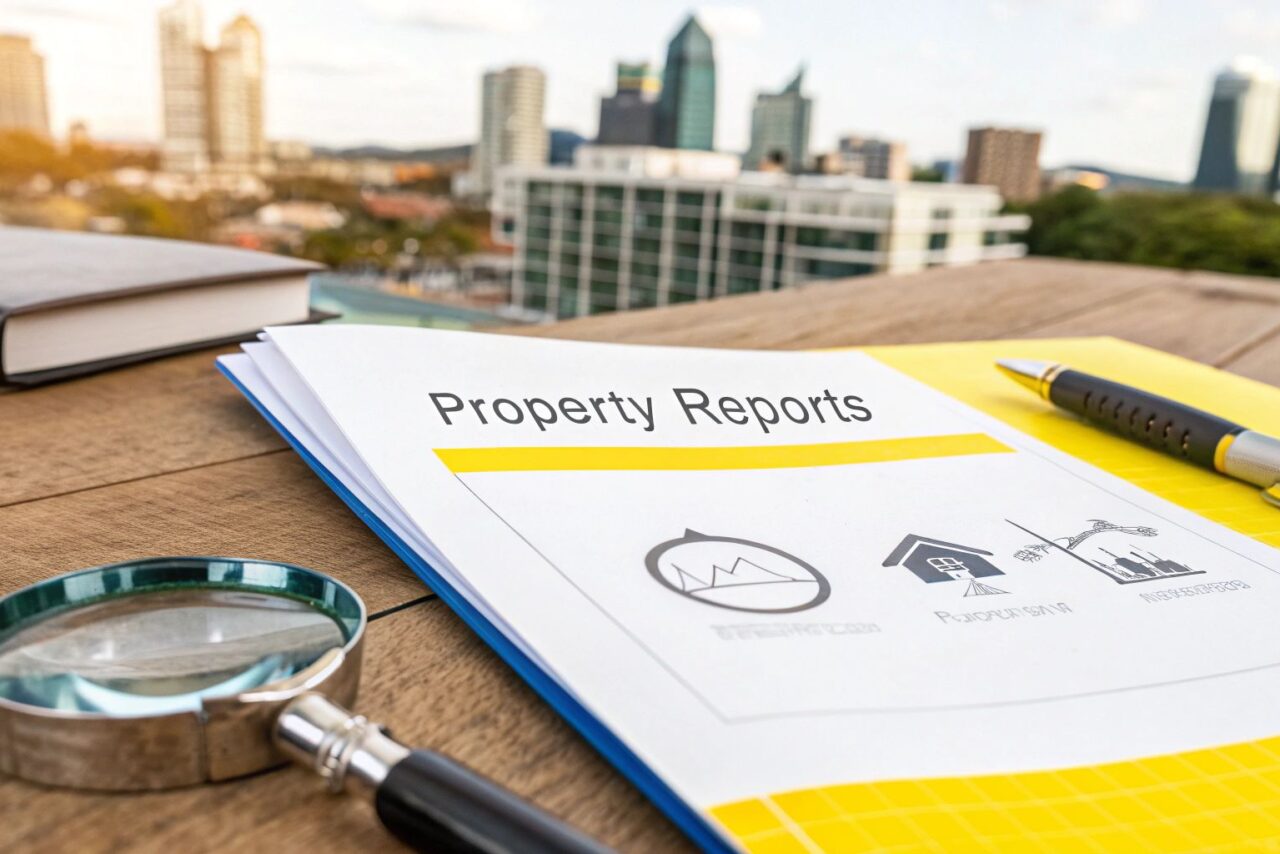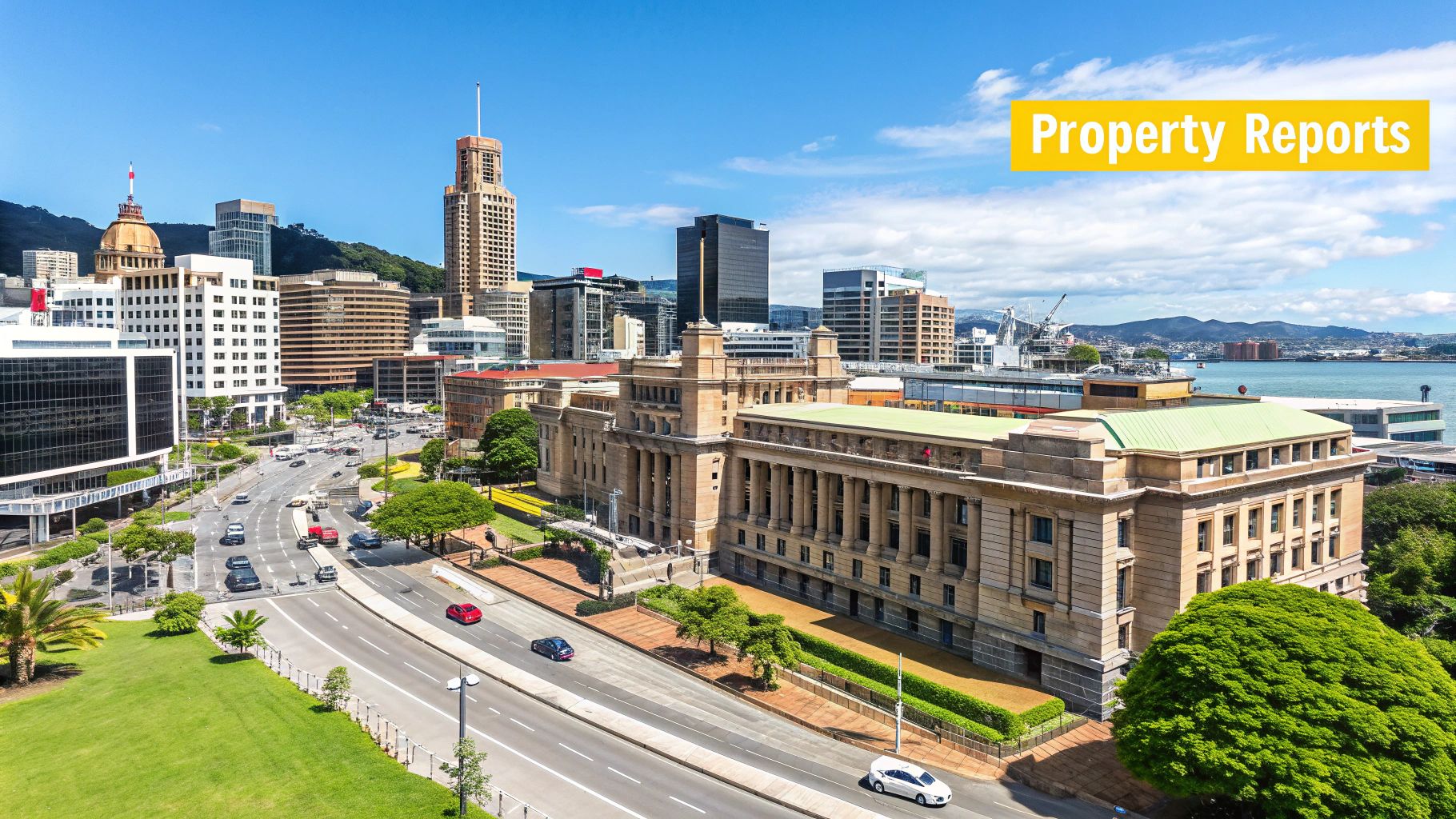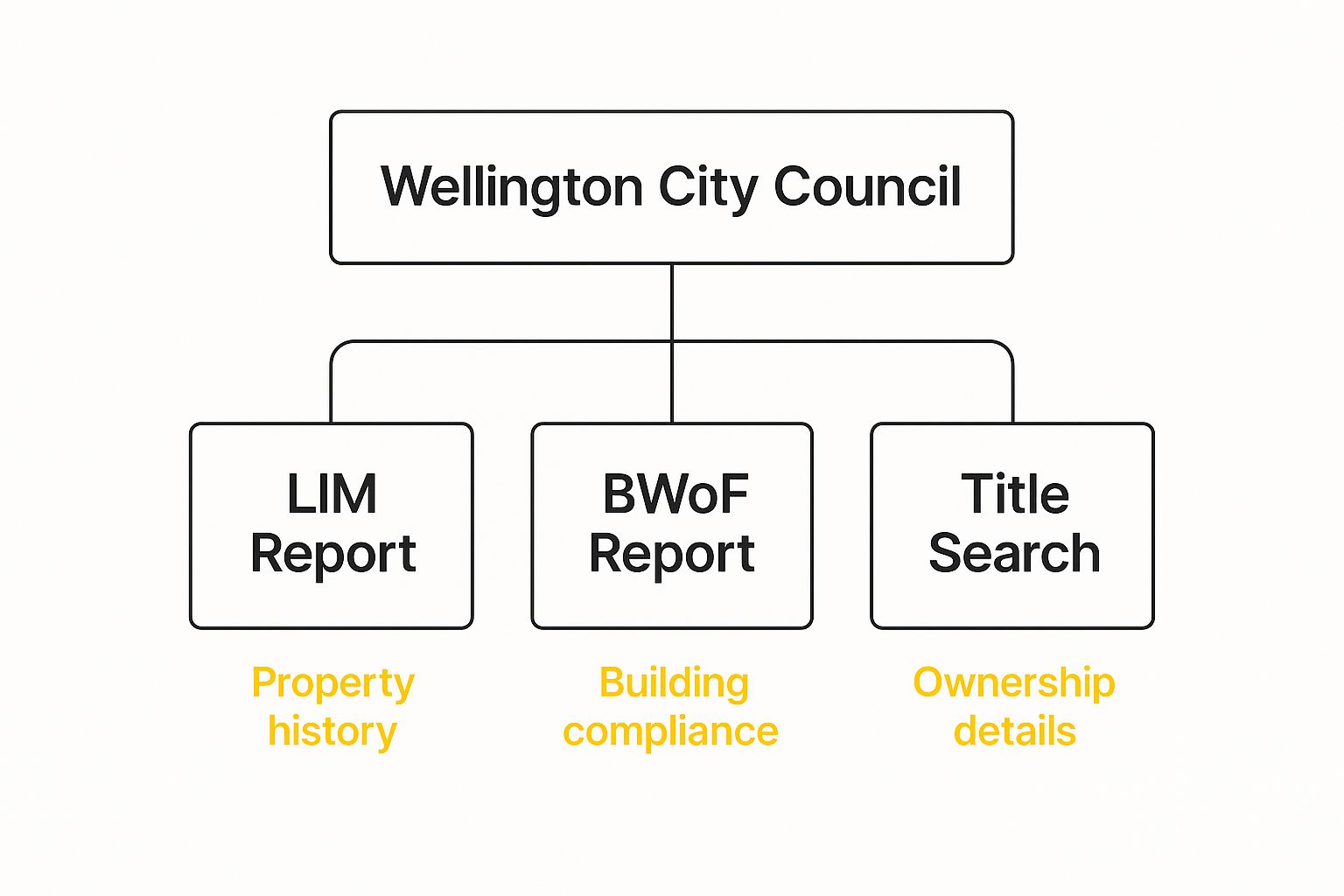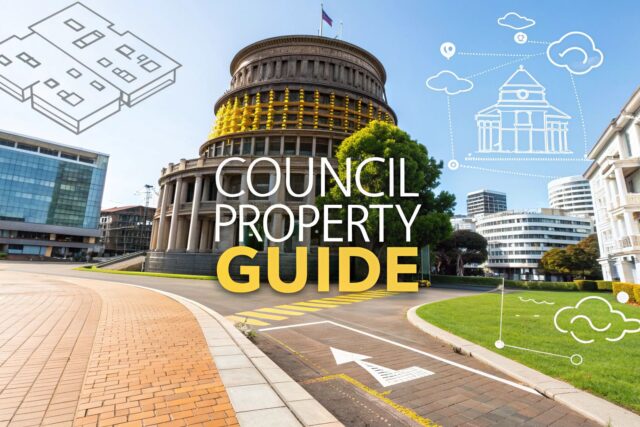
If you’re getting ready to sell your home in Wellington, one of the most powerful tools you can have is a Wellington City Council (WCC) property report. Think of it as the official story of your property, pulling together all the key information the council holds into one single, transparent document. This gives both you and potential buyers a clear snapshot of your property’s history, compliance, and boundaries.
Quick note before we jump in: The information here is just for general interest, it’s not official advice. Some of it’s based on opinion or pulled from property news sources that share useful tips, we do our best but we can’t guarantee it’s all spot-on or fully complete.
Why a Property Report Is Your Key to a Smooth Sale

Are you thinking of selling your home in suburbs like Karori, Wilton, or Mount Victoria? Getting a handle on the official paperwork tied to your property is the first step towards a successful and stress-free sale. With decades of experience navigating Wellington’s property market dynamics, I’m Halina, and I’m here to help you make sense of every detail.
A property report uncovers critical data that can prevent nasty surprises from popping up during negotiations. It allows you to present your home with confidence, giving buyers the assurance they need to put forward a strong offer. When you have this information ready from the get-go, you’re showing transparency and preparedness—two things every serious buyer values.
The Role of Property Reports in Due Diligence
For any property transaction, a Wellington City Council property report is an essential part of any good ultimate due diligence checklist. It brings together crucial data from the Building Information Report along with other vital property specifics.
The council offers these reports to make sure residents and prospective buyers have the information they need. You can request one online for a fee per residential unit, and it’s usually processed within just three working days.
Having this document ready not only speeds things up but also clarifies key aspects of property disclosures. You can learn more by reading our guide on property disclosures in New Zealand.
While the report is incredibly detailed, it doesn’t include building consent plans or their associated documents. Those can be accessed separately. You can find out more about requesting a property report directly from the council to get started.
What Information Is Inside a WCC Property Report
Think of a Wellington City Council property report as your home’s official biography. It’s a treasure trove of data pulled straight from council records, and it gives you a completely transparent foundation for your sale.
Getting your head around what’s inside is crucial. It lets you get out in front of any questions buyers might have and tackle potential issues before they even come up. It’s about turning that official data into a clear, compelling story for your home, whether you’re selling in Karori or Khandallah.
Key Components of a WCC Property Report
Let’s break down the main sections of a Wellington City Council Property Report. Each part tells a piece of your property’s story, and understanding them helps you present your home with total confidence.
| Report Component | What It Shows | Why It Matters for Your Sale |
|---|---|---|
| Aerial Photograph | A bird’s-eye view of your property, its boundaries, and surrounding area. | Gives buyers, especially those new to suburbs like Ngaio or Crofton Downs, valuable visual context of the property’s layout. |
| Computer Details | The property’s digital record, including its legal description and land area. | Ensures everyone is working from the same official information, preventing confusion down the line. |
| Rates Information | The current rating valuation (RV) and the total annual rates bill. | Helps potential buyers accurately budget for the ongoing costs of owning your home. |
| Drainage Plans | Diagrams of public and private wastewater and stormwater pipes on the property. | Essential for buyers planning extensions in suburbs like Brooklyn, as it shows where they can and can’t build. |
| Residential Rules | A summary of relevant rules from the District Plan that apply to your property. | Highlights future potential by outlining zoning regulations for modifications or new builds in areas like Newtown or Berhampore. |
| Encroachment Details | Notes if any structures (fences, garages) cross over onto public or neighbouring land. | Provides legal clarity and avoids potential boundary disputes for the new owner. |
| Building Consents | A history of all building permits and consents issued for the property. | Offers buyers peace of mind by showing a transparent record of all approved and compliant work. |
Knowing these details inside out means you’re prepared for any curly questions from discerning buyers. It shows you’ve done your homework and have nothing to hide.
Key Property and Planning Details
The first part of the report is all about the basics—the core facts that identify your property and its place in the Wellington landscape.
- Aerial Photograph: This gives a fantastic bird’s-eye view of your section and its approximate boundaries. For buyers who might not be familiar with the typical layouts in suburbs like Northland or Island Bay, this visual context is a game-changer.
- Computer Details: This is a summary of the property’s official digital file at the council, including its legal description and land area. It’s the single source of truth that ensures everyone involved in the sale is on the same page.
- Rates Information: The report clearly lays out the current rating valuation and the annual rates charged. This is exactly what buyers need to understand: the ongoing costs of owning your home. No surprises.
Building and Infrastructure Records
Now we get into the nitty-gritty. This section focuses on the physical structures on your land and the council services that connect to them. For many buyers, especially those eyeing up future renovations in places like Aro Valley, Berhampore or Brooklyn, these details are absolutely vital.
It provides a full history of building permits and consents the council have on file, offering a transparent timeline of all the approved work ever done on your home. This official record of compliance is a massive confidence booster for purchasers.
The report also dives into:
- Public and Private Drainage Plans: These diagrams show where the wastewater and stormwater pipes run. This is critical information for anyone planning an extension or major landscaping, as it immediately flags any potential restrictions.
- Summarised Relevant Residential Rules: This is a handy summary pulled from the District Plan, outlining what you can and can’t build or modify on your property. Understanding these zoning rules helps you market your home’s future potential with authority.
- Summarised Encroachment Details: This will note if any part of your property, like a carport or retaining wall, may cross over onto public land or a neighbour’s section. It’s a small detail, but it’s incredibly important for legal clarity.
This image gives a great overview of the different reports you might come across and what they’re used for.

As you can see, each report has a specific job, from checking building compliance to confirming legal ownership. While getting to grips with WCC reports is a great start, exploring wider property insights and industry discussions can really deepen your understanding of the real estate world as a whole.
Decoding Your Building Consent History

This is the part of any Wellington City Council property report that gets scrutinised the most. It’s where potential buyers—and especially their lawyers—will be looking for absolute certainty that all the work on your home is above board, safe, and fully compliant.
Getting your head around this section is key to presenting your property with confidence.
These records might look a bit technical at first glance, but they really just tell the story of your home’s structural life. A clean, complete history can make the due diligence process a breeze for buyers. On the other hand, gaps or missing paperwork can throw a real spanner in the works.
Understanding Key Compliance Documents
When you’re looking through your property file, you’ll see a few important terms pop up again and again. Knowing what they mean is crucial when you’re fielding questions from buyers.
- Building Consent: Think of this as the council’s formal green light to carry out specific building work. It’s their confirmation that the plans, if followed correctly, meet the New Zealand Building Code.
- Code Compliance Certificate (CCC): This is the final sign-off. Once the work is finished, the council issues a CCC to confirm it was all done in line with the original building consent. It’s the official ‘job done right’ certificate.
- Certificate of Acceptance (COA): This one is for work done without a building consent. While it offers some level of assurance, it’s not as solid or comprehensive as a CCC.
For instance, an unconsented deck added to a home in Brooklyn or a garage conversion in Ngaio could easily become a major sticking point for a buyer. These are common issues that can create hurdles if you don’t tackle them proactively. It’s also wise to keep up with related council policies, like the recent extension for earthquake-prone building deadlines, which also plays into property compliance.
What to Do About Unconsented Work
Finding unconsented work on your property file doesn’t have to be a deal-breaker. The first step? Don’t panic. There are almost always practical ways to sort it out.
Often, it’s just a matter of understanding exactly what was done and being transparent about it with potential buyers.
A proactive approach is always best. Addressing unconsented work before your home goes on the market gives you control over the narrative and prevents buyers from uncovering surprises themselves.
With decades of experience in the Wellington market, I’ve helped countless homeowners navigate these exact situations. I have a professional network of contacts from builders and engineers to consultants who can assess the work and map out the best path forward. This might mean applying for a Certificate of Acceptance, or it could be as simple as ensuring the work is properly disclosed.
By tackling these things head-on, we can turn a potential headache into a resolved issue, making sure your property is ready for a smooth and successful sale. If you have any worries about your property’s consent history, let’s have a chat.
Navigating Drainage and District Plan Rules

For any buyer with an eye on future renovations, the drainage plans and District Plan rules in your property report are absolute gold. This part of the report can look a bit technical at first glance, but understanding it is the key to showing off your property’s true potential.
Think of these documents as the official roadmap for what can and can’t be done on your land. When you get to grips with them, you can turn what seems like complex red tape into a major selling point.
Understanding Drainage Plans
The drainage plans in your WCC property report show exactly where the public and private stormwater and wastewater pipes are located. This is critical stuff, especially in Wellington’s classic character suburbs like Thorndon or Aro Valley, where the underground infrastructure can be a real maze.
A buyer dreaming of adding an extension or a sleepout needs to know precisely where these pipes run to avoid any costly surprises or build-over restrictions. Being able to point out a clear, unencumbered building area on the property can be a massive advantage.
Connecting to the District Plan
The District Plan lays down the zoning rules for your neighbourhood, defining what’s possible for future development. These rules can change dramatically from one suburb to the next.
- High-Density Zones: In spots like Te Aro or Mount Cook, the rules are geared towards encouraging more intensive development. This could be a huge drawcard for a developer or a buyer keen on adding a second dwelling.
- Character Precincts: Over in suburbs like Wadestown or Mount Victoria, the focus is all on preserving the area’s unique heritage. This really appeals to buyers who value that special neighbourhood charm.
Knowing your property’s specific zoning inside and out is essential. It means you can confidently market its potential, whether that’s the freedom to add a second storey or simply the peace of mind that the neighbourhood’s character is protected. For a deeper dive, you can explore our detailed guide on Wellington’s zoning rules.
Wellington City Council has actually been a trailblazer in making this kind of data easy to access. Since 2010, they’ve released a huge amount of geospatial data, including things like utility networks and building footprints, helping everyone make more informed decisions. You can discover more about Wellington’s open data initiatives, which have become an invaluable local resource.
Let an Expert Guide You
Trying to make sense of a dense Wellington City Council property report can feel overwhelming. But you don’t have to tackle it by yourself. This is exactly where having an experienced local professional in your corner can turn a confusing stack of papers into a clear path forward.
My job is to help you read between the lines, interpret every detail, and figure out how to present that information in the best possible light. Understanding your property file is one thing, but what if it throws up a curveball, like some unconsented work or a tricky boundary line?
That’s when my professional network becomes your biggest advantage. After decades in Wellington real estate, I’ve built fantastic relationships with a whole team of experts who can assist with most real estate-related services, whether it’s legal, financial, or property maintenance. This includes top-notch lawyers, reliable builders, and creative home stagers who can help get your home ready for the market proactively.
We’ll work together to get all your ducks in a row and tackle any potential issues before your property is even listed. This gives buyers the confidence they need to come forward with their best offers. If you’re thinking of selling, let’s have a chat about your individual circumstances. A complimentary, no-obligation free appraisal is the perfect first step to understanding exactly what your Wellington home is worth in today’s market.
Myth-Busting and FAQs
When selling a home in Wellington, there are always plenty of questions about the paperwork. Let’s tackle some of the most common myths I hear about council property reports to give you clarity and confidence.
Myth: A high CV means a high sale price.
Reality: This is a common misconception. The Capital Value (CV) is a council valuation for rating purposes, updated only every three years. In a fast-moving market like Wellington, the CV quickly becomes outdated. For instance, a home in Mount Victoria might have a CV that doesn’t capture the value of a recent renovation or its current desirability. The true market value is determined by what buyers are willing to pay today, which is influenced by current demand, bank lending rates, and the RBNZ official cash rate (OCR). This is where my appraisal can help.
Do I really need a property report to sell my home?
Answer: Legally, no. But practically? It’s a very smart move. Most serious buyers, and definitely their solicitors, will request a property file as part of their due diligence. Handing one over right from the start shows you’re an open and prepared seller, which builds trust and speeds things up, leading to cleaner, more confident offers.
What’s the difference between a Property Report and a LIM?
Answer: Think of it this way: a Property Report focuses on the buildings. It dives into consents, permits, and drainage plans—the history of the structures. A Land Information Memorandum (LIM) is the bigger picture. It includes everything from the Property Report but adds crucial details about the land itself, like erosion risks, heritage status, or special land insurance considerations. A LIM is the gold standard, but a Property Report is often the perfect starting point.
What should I do if the report shows unconsented work?
Answer: First off, don’t panic. This is surprisingly common across Wellington. The first step is to get professional advice to understand what you’re dealing with. Depending on the work, you might be able to apply for a Certificate of Acceptance or simply disclose it to buyers. As your agent, I can help guide you and connect you with the right people, builders and legal experts to find the best way forward. It’s always best to seek professional legal advice before making any final decisions.

.
.
.
.
.
.
.
.
.
.
.
.
.
.
Disclaimer: The real estate content shared on this blog is intended for general informational purposes only and industry observations. The content may reflect personal views or reference third-party sources, but it is not a substitute for tailored professional advice. Real estate decisions often involve legal, financial, and regulatory complexities, and readers should seek independent guidance from qualified specialists such as legal advisors, financial consultants, or compliance professionals before acting on any information presented here. No warranty is given as to the accuracy, completeness, or current relevance of the material.




